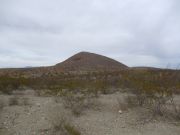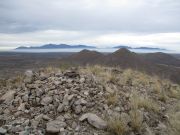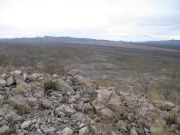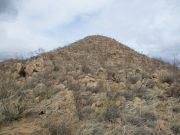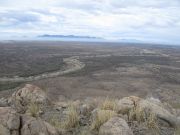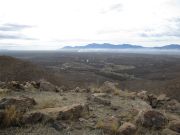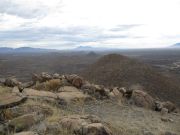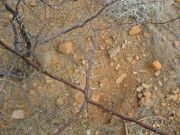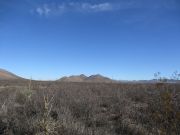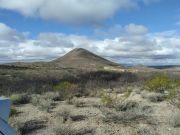
The Mountains of Arizona
www.surgent.net |
|
Charleston Lead Mine Peak • Peak 4628 I wanted to explore the area around the ghost town of Charleston, which today lies about halfway between Sierra Vista and Tombstone. Charleston and its sister city Millville were established in 1878-79 along the banks of the San Pedro River as the milling sites for the silver (and other metals) ore that was mined out of Tombstone, which itself was just getting started. Charleston was the main town, built on the west banks of the San Pedro, whose dependable flows provided the power needed for its stamping mills. Millville was on the east bank and the location of the mills. Charleston was the location of the houses, stores, saloons, livery stables and all the trappings of 1870s-1880s life. In 1886, the mines in Tombstone flooded, which severely crimped the economy of Charleston and Millville. In 1887, a massive earthquake in northern Mexico was powerful enough to cause damage in southern Arizona, and it wrecked many of the remaining structures. Tombstone was now able to mill its own ore, and by 1889, both Charleston and Millville were ghost towns. These days, there is very little to actually see of both towns. The river itself, through its natural ebb and flow and occasional storm-driven flows, ate away at the banks and took down any remaining adobe structures. Other settlers would scavenge what they could. The military later used the ghost towns and the area for training, this being around World War II. In recent years, most of the San Pedro River has been surrounded by the San Pedro Riparian National Conservation Area, administered by the Bureau of Land Management. Hiking trails have been put in, and it can be accessed at any of the main roads that cross over the river, which still flows quite strongly. There are five ranked peaks that are clumped near the Charleston-Millville sites, four that lie within the Riparian Area boundaries, and one that lies barely outside, on State Trust Land. There was no way I was going to hike all five today. While "clumped", each has its own approach so it's not practical to fan out from one central point to the peaks. My intention was to look at the two on the east bank, then maybe wander south over to Brunckow Hill if I felt like it. I would scout the area overall, get an impression what the roads and access are like, and what kind of terrain I'd be dealing with.
Date: December 19, 2023
• Elevation: 4,505 feet
• Prominence: 345 feet
• Distance: 1.3 miles
• Time: 70 minutes
• Gain: 425 feet
• Conditions: Heavy clouds, mild temperatures
Arizona
•
Main
•
PB
•
LoJ
•
Interactive map
I left the house in Bisbee at 7:40, got gas, then returned to my home because I had forgot my phone. I then headed out again, following state route AZ-92 south then west through "south" Bisbee and west toward Sierra Vista. I left the highway early, making a right onto Hereford Road. I wanted to explore some of these back routes.
Hereford Road diagonals northwest, then west, and crosses the San Pedro over a single-lane bridge which I thought was pretty nifty. I stayed on Hereford Road for a few more miles, then went right (north) on Moson Road. The map said it would intersect Charleston Road not far from the river. Everything worked out fine, and I was on Charleston Road, now heading northeast toward Tombstone.
I wanted to explore Peak 4505, or Charleston Lead Mine Peak, first. It lies just outside the Riparian Area boundaries on State Trust Land. I found the ingress road, which was decent hardpack. It had the usual State Trust, No Trespassing, Permit Required signs. I drove in not far, a half mile or so on a road that parallels power lines, then turned left onto a lesser track, and parked in a clearing.
After my delays, it was almost 9:30 when I turned off the engine. The day was heavily clouded, but with no likelihood of rain. It was mild, temperatures in the 50s, and there was a large field fire going on nearby which blanketed the entire area under a layer of white smoke.
I started walking, following the track northward, then leaving it and going up and over a little hill, down to a lower road at the base of the main hill itself. To the north was the old Charleston Lead Mine, which is no longer active. Many of these roads were put in to service the mine.
The Charleston Lead Mine was mainly active in the 1940s through the early 1960s, featuring both underground shafts, then open-pit mining. These days, it's been mostly filled in and all I saw today was a lot of bare dirt, but no buildings or machinery.
I followed a much scanter track that angled uphill, now on the hill's northern base. It made one bend, angling back, then just ending. The tread is rough and mature brush grows in the middle, suggesting no vehicles have been up here in years. I simply followed this track figuring any uphill I can make on this track is that much less I need to do pushing through the brush.
It took a few minutes to find a way onto the slopes above me, as the track had been carved into the hillside, creating little five-foot road-cut "cliffs". I found a spot, then just started the uphill grind. The brush was moderate, sometimes thick, almost all of it about knee high. I found a few lanes, but most of the time had to push through the clumps, which wasn't too troublesome. The worst was the whitethorn acacia brush, with thorns up to an inch long. I just worked around those. There was virtually no cactus.
This "off road" segment only covered about the last 150 feet and I was on top quickly. The short summit ridge was open with less brush, and the summit itself was bare, with one big rock pile. I found a register and signed in. Mark Nicholls was here in 1992, a group from Tombstone was here a few years ago, and Andy Martin was last here in early 2021. I knew Andy had been here when the half-inch pencil he's known for providing fell out of the jar.
I sat for a few minutes and had a snack and a look around. The weather was holding, just a lot of clouds and nothing else. There was no breeze. Views were okay. I could see long distances, but the colors were all muted. This had to be the grayest peak I've ever climbed. I stayed up top for about five minutes.
The downhill hike went fine. I just had to watch the sudden slips and avoid the thorns. I was back to the tracks and then followed a different road back to my car, having seen it from above. I had been gone for 1 hour and 10 minutes, covering a mile and a half.
This peak went well with no logistical issues, but it wasn't anything special. I was happy to get it into the books. I did sense that this is really the only time to be hiking these peaks. I can picture this brush, all green in Spring, and probably impenetrable.
Elevation: 4,628 feet
• Prominence: 528 feet
• Distance: 3.9 miles
• Time: 2 hours
• Gain: 640 feet
• Conditions: Still cloudy, a tiny bit of sun
PB
•
LoJ
I returned to Charleston Road and drove it westbound for less than a mile, pulling off into the Millville Trailhead and parking area. I was the only one here. Since I was still dressed and packed, I was moving quickly, starting this hike at 10:50 a.m..
I stepped past the stile and followed a trail a few yards to where it connected with the main trail which starts a little more south, also accessed by the same lot I had parked in. This trail goes north and drops into a tributary channel of the San Pedro River. It crosses this sandy and brushy channel, then starts up the other side. There are then two Y-junctions, and I stayed right at both, both signed as the San Pedro Trail.
Then it was just a longish hike along this trail as it approached a lower peak, then curled east then north, essentially circling this foreground peak in a counterclockwise manner. The higher peak, Peak 4628, was visible some of the time, a rounded dome of a peak set farther back relative to my position.
I walked until I was east of the saddle that connects Peak 4628 and the lower peak I mentioned. I had covered a little over a mile in about 20 minutes, moving quickly on the good trail. It appeared to me to be an old road.
The easy part was now over. I left the trail and started weaving through the brush, which at first was sparse enough so that I could keep a bearing without needing to make detours every five feet. I gained a gentle hill then dropped about 20 feet, now on the slopes of the lower peak.
From here to the saddle was about a 300-foot gain up brushy slopes. The gradient was very lenient, but the brush was thick. I would find a lane that went for thirty feet, then nothing. It was a mix of creosote, some ocotillo, acacia and mesquite, and all sorts of grassy and tangly shin-high stuff. I simply pushed through it, trading economy for style.
This segment wasn't fun but it worked and I was soon at the saddle. Looking up, the summit was in view. Between me and it was a slope of heaped rocks and much less brush.
The rocks were piled in just the right way, never too steep, and usually solid (a couple teetered). I could walk and hop from one rock to another for yards at a time. I made excellent time, and was having a lot of fun, too. Toward the top, the rocks heaped a little more steeply and I used my hands a couple times to hoist up a rock, and just like that, I was at the top.
The summit is a platform with a rocky jumble in its center and a few large ones on the fringe. I felt a large rock central to all the others was the highest point, but I tagged a few others just to be sure. I looked for a register but could not find one. The sun was barely peeking out from the clouds for the first time today and I got some decent images. I found an excellent sitting rock and took a five minute rest break.
Looking down, I could see the big cottonwoods lining San Pedro River, cutting a wiggly swath across the desert. Two weeks ago, on my runs to and from Bisbee to move my furniture over, these cottonwoods were bright orange and absolutely stunning. Today, they were gray, every single one. Note to self: come back when the trees are in Fall colors again.
I hiked down the same way, enjoying the rock hopping and then just dealing with the thorny brush until back to the trail. Truthfully, this bushwhacking wasn't the worst, and I was able to push through it reasonably well, but it was thorny and grabby. Those acacia thorns are something else. I only saw a couple barrel cactus.
I made a slight detour to look at the ruins of Millville and decided I'd come back some other day and take some time to check them out, plus some petroglyphs in the area. I was back to my car a little after 1 p.m., for a hike of just over two hours.
This was a fun hike and the rock-hop ridge was enjoyable. But like I said earlier, when this brush gets green, it probably gets impenetrable, not to mention snakey.
I returned to Bisbee the same way, Charleston to Moson to Hereford to AZ-92. I made a grocery run, and was home a little before 3 p.m..
I'll definitely return. Brunckow Hill to the south looks like an interesting hike and I want to also check out the Brunckow Cabin ruins, supposedly haunted as nearly two dozen men were killed there over many years. Two other peaks to the northwest look like fun but I am not yet sure how to get closer to those.
|
|
